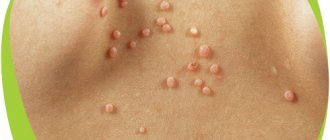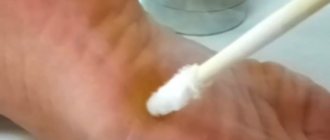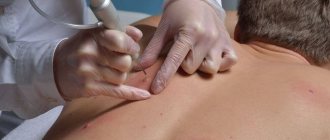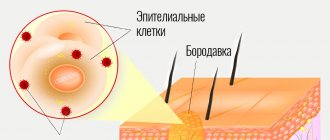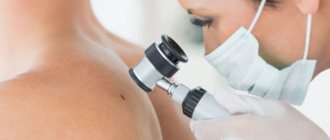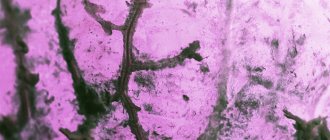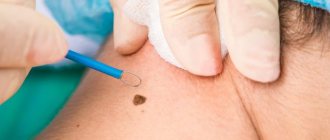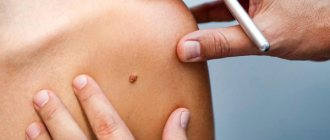To avoid complications and speed up the healing of an injured area of skin after removing a plantar wart or located in any other place, it is necessary to follow certain rules.
Upon completion of the wart removal procedure, medical doctors must instruct the patient in detail about the procedure and standards for wound care and select the optimal medications. Our clients can receive a full range of high-quality services in Moscow, at the clinic on Kashirskaya metro station, and in Ramenskoye, on the street. Chugunova, 21-A.
How is cryodestruction performed?
A freezing agent called cryogen (usually liquid nitrogen) is used to directly apply extreme cold to unwanted skin growths. Cryogen is applied to the target area where it destroys skin tissue and also stimulates a local immune system response. Over time, the unwanted tissue will crust over and then fall off, leaving behind healthy tissue to heal and repair itself. Along with the cosmetic benefits (clearer skin), young patients and their parents can rest easy knowing that unwanted tissue growth no longer poses a potential health threat.
Although liquid nitrogen is the most commonly used cryogen, there are other substances that can be used depending on individual circumstances. Cryogen is applied with a thin stream from a medical spray bottle. A cotton swab can also be used as an applicator. Treated skin will naturally tingle a little and then usually blister. The pain experienced is surprisingly tolerable if the procedure is performed by an experienced dermatologist.
After a few days, a scab will form, which will dry out and fall off over the next week or two. In severe cases, repeat cryotherapy is used to ensure complete removal of the lesion with little chance of recurrence. Cryotherapy is an inexpensive, reliable and safe procedure, but should only be performed after an accurate dermatological diagnosis, as the procedure is not suitable, for example, for the treatment of aggressive melanoma.
Features of removing warts with liquid nitrogen
Cryodestruction is the process of destroying wart cells by exposing them to extremely low temperatures. Nitrogen is used as the main active ingredient. It liquefies at a temperature of –196 °C, and when it rises it becomes a gas again.
To remove a wart, it is treated with nitrogen using special equipment - a cryoprobe. Under the influence of such a low temperature, the water in the overgrown epithelial cells that make up the warts instantly freezes, expands and destroys them. This process can be quite painful, so in some cases local anesthesia is used.
Immediately after treatment, the wart turns white, then the operation site turns red and swelling appears. The formation of a blister filled with serous fluid and blood is a normal condition of the affected area. The process of its resorption usually takes one to two weeks. It all depends on the size of the wart, the depth and correctness of its treatment. Afterwards, a crust forms, which may peel off during the healing process. The period of complete recovery takes 2 weeks or more. Smooth, even skin should form at the site of the wart, the color of which will subsequently even out.
Skin care after cryodestruction
The lesion does not require a bandage after treatment. The application site can be gently washed daily with salt water or saline. Additional care of the treated area is usually limited to a bandage to cover the area while healing, especially if the area is in an area where clothing will chafe and cause discomfort during healing.
The resulting blisters may be large and hemorrhagic (filled with blood). They should not be cut or stripped. If the size and inconvenience are significant, you can release the liquid with a sterile needle without damaging the bladder itself.
Once the blister has turned into a scab, Vaseline can be applied to soothe and moisturize the wound. Picking or cutting away the scab should be avoided to facilitate natural healing processes, allowing the scab to fall off in its own time. The rate of healing varies across different areas of the body, with scab usually remaining on the lower legs much longer than on the face or arms. In most cases, the end result will be completely normal skin without any signs of damage.
The cryodestruction procedure causes stinging, burning pain. Freezing lesions on the palms, soles, ears, lips and eyelids is more painful than anywhere else. Freezing the affected areas of the forehead and scalp can cause headaches. If necessary, you can give your child a pain reliever (ibuprofen).
Indications and contraindications for cryodestruction
As a rule, patients decide to remove skin tumors wanting to get rid of cosmetic defects. First of all, it is recommended to remove moles and warts located in “unsuccessful” areas where they are regularly injured.
There are practically no contraindications to cryotherapy: it is recommended even for children, if necessary. But there are cases when it does not give the desired effect, for example, if the diameter of the tumor exceeds 4 mm.
It is better to refrain from cryodestruction during infectious and inflammatory processes until they are cured.
Make an appointment Do not self-medicate. Contact our specialists who will correctly diagnose and prescribe treatment.
What complications can there be during the procedure?
- Immediate complications: pain, fainting, headache, swelling (especially periorbital), blistering.
- Delayed: infection, bleeding, slow healing.
- Long-term but temporary: hyperpigmentation, milia.
- Constantly: hypopigmentation, ectropion, atrophy, alopecia.
The procedure is usually safe if done carefully, although there are sometimes exceptions. For example, cryotherapy treatments near the eyes may cause the eyelid to swell for a day or two, although the swelling will soon subside.
Causes of warts
Prerequisites for the formation of warts:
- neglect of personal hygiene rules (using someone else's shoes, washcloths, towels, manicure and pedicure instruments);
- increased skin moisture, especially hyperhidrosis of the feet and hands;
- immunodeficiency states of the body (HIV infection, cancer, treatment with cytostatics, viral hepatitis B and C);
- chronic stress;
- chronic dermatoses requiring treatment with external hormonal agents (atopic dermatitis, psoriasis, eczema and other itchy dermatoses);
- metabolic disorders in the body and hormonal dysfunctions.
Warts also often appear on thin baby skin.
Cost of the procedure
| Name | Price |
| Removal of molluscum contagiosum (as part of a consultation with a dermatologist) 1-3 units | 550 rub. |
| Removal of molluscum contagiosum (as part of a consultation with a dermatologist) 4-5 units | 700 rub. |
The information and prices presented on the website are for reference only and do not constitute a public offer. The services indicated in the Price List may be provided in other medical institutions. We ask you to clarify the address and cost of services in advance at the 24-hour call center by phone +7 (812) 331 17 04
What is the difference between cryodestruction of papillomas and warts?
Both papillomas and warts can be classified as skin formations, the removal of which is recommended by doctors. They are similar in structure and resemble slightly elongated, flat or thread-like protrusions. These are benign formations caused by the papilloma virus. Over time, they do not transform and cannot become malignant, but, nevertheless, they cause a lot of inconvenience: they look ugly, cling to clothes, and can be damaged.
The method for removing warts and papillomas is the same: you need to freeze the intracellular structures of benign formations, as a result of which the virus will die, and the skin can be cleansed painlessly. The cryodestruction technique in Moscow is no different from the removal mechanism in other cities: this method has long been tested and does not cause side effects. But by doing cryodestruction of warts at a competitive price at the SkinLaser clinic, you not only save, but also receive high-quality and prompt care, as well as preliminary professional consultation. The nitrogen exposure itself occurs quickly: 30 seconds for each formation. If the papilloma or wart is large, exposure to liquid nitrogen can last 1-2 minutes.
Contraindications
- Pregnancy
- Infectious and viral diseases
- Rash near the site of exposure
- Epilepsy
- Angiospasm
- Individual nitrogen intolerance
Recommendations after the procedure
- After cryodestruction, a bubble forms that should not be opened independently.
- After 4-5 days the bubble will burst on its own
- After opening the bubble, this place of nitrogen must be treated with an antiseptic
- A bactericidal patch should be applied to the site of the bubble.
- Swimming after the procedure is not prohibited - this can be done from the first day
Expected result: will there be scars and how many sessions are needed?
After cryodestruction, the growth dies and is gradually replaced by healthy skin. At first, the removal site resembles a burn, and then becomes covered with a crust. If you don’t peel off the scab and let it fall off on its own, there will be no scar left.
Deep tumors are not removed at once, so as not to damage healthy tissue around it by too intense freezing. In this case, 2-3 sessions are prescribed with an interval of 3-4 weeks.
How long does it take for skin to heal after cryodestruction?
After cryodestruction, the treatment area turns red and swells within 2-3 hours - this means the blood supply is restored. A blister appears at the site of formation, which gradually dries out and becomes covered with a crust. The scab then peels off as new, healthy skin forms underneath. This process takes 3-4 weeks. The shade and structure of young skin will differ from the rest of the skin for some time. After 4-5 months this difference will no longer be noticeable.
Which is better: cryodestruction or laser removal
The difference between cryodestruction and laser removal of tumors lies in the technique of the procedure and the duration of the postoperative period.
- During laser removal, the growth is evaporated, and during cryodestruction, its tissue is frozen.
- Larger formations in skin folds and mucous membranes are removed with laser, and small ones in open areas of the body are removed with liquid nitrogen.
- Laser removal is more accurate, therefore it damages less tissue, but leaves an open wound. Cryodestruction covers a larger area, but is considered less painful and does not require anesthesia.
Only a doctor can choose the appropriate removal method. You can find out whether cryodestruction is suitable for your case or whether you should choose another method at an appointment at Dr. Kurenkov’s clinic. We are waiting for you in Moscow at Rublevskoye Shosse, 48/1.
Preparation and process
How to prepare for the procedure
Before removing warts with nitrogen, half an hour or an hour beforehand, you need to take a painkiller tablet from the NSAID category (analgin 0.5 mg, ketonal 100 mg), if there are no contraindications to them. If you are worried, you can take a herbal sedative (valerian, motherwort and others) before the procedure.
Process description
During nitrogen removal, the doctor uses a special stick wrapped in sterile cotton wool and moistened with nitrogen to touch the areas of skin with warts, freezing them. The procedure consists of several freezing and thawing cycles. It is possible to use other tools, but their operating principle is the same.
What to do after deletion
After removing warts with nitrogen, you need to treat the wounds with the medications prescribed by the doctor. These can be means for quickly drying blisters (potassium permanganate, calendula), antiviral (for HPV) or antimicrobial agents (antibiotics), as well as ointments to reduce the severity of swelling. The doctor decides this individually in each case. Blistering and swelling is normal after nitrogen removal. In most cases, swelling goes away on its own within a few days. The blisters dry up within a week after ordinary warts or two after plantar warts.
What diseases can be treated with cryodestruction?
Dermatological _
Riosurgery allows you to treat a wide range of benign and precancerous skin conditions, such as:
- Angiomas
- Warts, including plantar warts
- Seborrheic and actinic keratosis
- Birthmarks
- Age and sun spots
- Dermatofibromas
- Molluscum contagiosum
- Condylomas
- Hemangiomas
- Acne
- Keloids
In most cases, a single application of cryodestruction is sufficient. Keloids require three times of treatment in two months, and dermatofibromas and ingrown toenails require two times of treatment in two months.
The main advantages of cryosurgery:
- Low cost of treatment
- No pain thanks to a combination of precision, freezing temperature and freezing power.
- Fast and effective treatment in intensive practice conditions
- No preparation time required
- Anesthesia is optional
- Excellent cosmetic results
- No need to remove sutures
- Minimal wound care
- Safe procedure
- Low risk of infection
- No bleeding
- No restrictions on physical activity
What is basal cell carcinoma, why does it develop in humans, why is it dangerous?
Basal cell skin cancer, carcinoid or corrosive skin ulcer are synonyms for basal cell carcinoma. This tumor is formed from atypically changed cells of the basal layer of the skin.
Content:
- What is basal cell carcinoma, why does it develop in humans, why is it dangerous?
- Cryodestruction: what is the essence of the method
- Indications and contraindications of the method
- Advantages and disadvantages of cryodestruction compared to other methods of treating basal cell carcinoma
- How basal cell carcinomas are removed using liquid nitrogen
- How to care for the wound surface after removal of basal cell carcinoma
- Possible complications after the procedure: what is the danger of cryodestruction of basal skin cancer
The prevalence of the disease practically does not depend on skin type. The tumor mainly affects people over 50 years of age. Of all types of skin cancer, basal cell carcinoma occurs in approximately 70-80% of diagnosed cases.
Interestingly, the disease more often affects men than women - the risk of getting the disease for a man over 50 years of age is about 35%, for women of the same age - 20-25%.
The tumor disease has its own specifics - it develops only on the skin, and is most often found on the face and scalp - in approximately 90% of all cases. The remaining 10% implies the location of the formation on the trunk, upper or lower extremities.
A characteristic feature of a tumor is its malignancy. The neoplasm develops without any membrane; it does not grow in a capsule, but simply penetrates into the tissue, disrupting their normal structure. At the same time, basal cell carcinoma grows not only in depth, but also tends to expand the affected area, thus affecting significant volumes of nearby tissues. By going deeper into the lower layers of the skin, it can reach the subcutaneous fatty tissue. Usually, the depth of skin damage can be judged by the area of external damage, since they are directly proportional to each other.
Due to the fact that the tumor usually progresses at a rate of no more than 5 millimeters per year, it can be effectively treated with cryodestruction.
The main difference between basal cell carcinoma and other malignant skin tumors is that it does not provoke the development of metastases to nearby tissues.
To date, medicine has not yet established the exact causes that cause the development of basal cell carcinomas. Among the likely catalysts for the process of atypical cell growth:
- frequent exposure to UV radiation;
- light skin color type with a tendency to develop burns and freckles;
- exposure to arsenic on the body, for example, due to prolonged consumption of water containing it;
- frequent prolonged contact with carcinogenic substances, ionizing radiation;
- disturbances in the functioning of the immune system;
- Keroderma pigmentosa;
- Gorling-Goltz syndrome;
- burns, ulcers and scars on the skin.
The danger of the disease lies in the fact that, despite its slow growth, basal cell carcinoma is capable of destroying deeper layers of tissue over time, especially on the head, affecting nearby organs - the eyes, ear apparatus, skull bones and membranes of the brain, which can lead to death .
